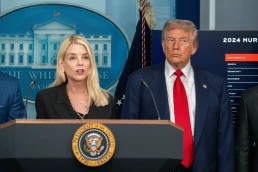President Trump is seeking a record $1 trillion budget for the Pentagon in 2026. What else could we do with that much money?
By Hanna Homestead, National Priorities Project
President Trump is requesting a record-high $1.01 trillion “defense” budget for FY 2026 while gutting federal agencies and social services that actually keep the country safe – things like clean air and water protection, Medicaid, child nutrition programs, the Department of Education, green energy, and so much more.
The U.S. already spends more on the military than the next nine countries combined despite the Pentagon being the only federal agency that has never passed a federal audit. The United States government alone operates more than 90% of the world’s foreign military bases, controls more than 42% of the world’s nuclear warheads, and dominates 43% of the global arms trade.
As the world’s largest arms dealer, the U.S. sells weapons to the majority of the world’s authoritarian governments and U.S.-made weapons are routinely implicated in human rights abuses – including facilitating Israel’s genocidal assault on Palestinians in Gaza, ethnic cleansing of the occupied West Bank, and fueling the brutal proxy war in Sudan.

Half of the trillion-dollar Pentagon budget will be handed over to corporations and lobbyists who profit from producing weapons that drive political repression, endless war, and climate collapse – including billionaires like Elon Musk. The budget also includes funding and authorization for domestic use of the military to facilitate mass deportations and detentions at an unprecedented scale.
While Pentagon contractors are set to receive record-high public subsidies, too many Americans are struggling to meet their basic needs. Despite being the richest country in the world, the U.S. has the lowest education and health outcomes and highest rate of child poverty among all economically advanced nations. Wealth inequality has never been higher – and three-quarters of the country are pessimistic about their children’s financial future.
Recent Posts
The “President Of Peace” Prepares For War
December 23, 2025
Take Action Now The Donroe Doctrine Hits HomeBy William D. Hartung, Tom Dispatch Earlier this month, the Trump administration released its new…
“Who Are They Protecting?”: Rep. Ro Khanna Urges Contempt Charges Over AG Bondi’s Epstein Redactions
December 22, 2025
Take Action Now “The House can act unilaterally on contempt, and this will be introduced by Thomas Massie. What the resolution will say is that…
Dems Demand Answers as Trump Photo Disappears From DOJ Online Epstein Files
December 21, 2025
Take Action Now “What else is being covered up?”By Brett Wilkins, Common Dreams Congressional Democrats on Saturday pressed US Attorney General…
Elon Musk Is Vowing Utopia Driven by AI and Robotics. Bernie Sanders Has a Few Questions
December 20, 2025
Take Action Now “I look forward to hearing about how you and your other oligarch friends are going to provide working people with a magnificent life…




